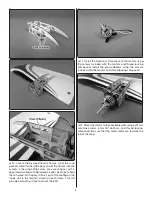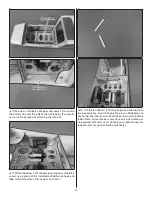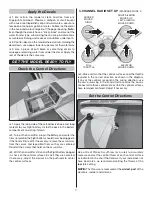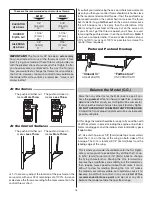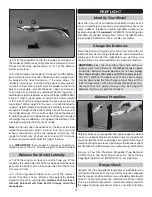
21
❏
9. Confirm that all controls operate in the
correct direction and the throws are set up
according to the manual.
❏
10. Make sure there are silicone retainers on all the
clevises and that all servo arms are secured to the
servos with the screws included with your radio.
❏
11. Secure connections between servo wires and
Y-connectors or servo extensions, and the connection
between your battery pack and the on/off switch with
vinyl tape, heat shrink tubing or special clips suitable for
that purpose.
❏
12. Make sure any servo extension cords you may
have used do not interfere with other systems (servo
arms, pushrods, etc.).
❏
13. Balance your propeller (and spare propellers).
❏
14. Tighten the propeller nut and spinner.
❏
15. Place your name, address, AMA number and
telephone number on or inside your model.
❏
16. Cycle your receiver battery pack (if necessary)
and make sure it is fully charged.
❏
17. If you wish to photograph your model, do so
before your fi rst fl ight.
❏
18. Range check your radio when you get to the
fl ying fi eld.
FLYING
The Twinstar EP ARF is a great-fl ying model that fl ies smoothly
and predictably. The Twinstar EP does not, however, possess
the self-recovery characteristics of a primary R/C trainer and
should be fl own only by experienced R/C pilots.
CAUTION:
(THIS APPLIES TO ALL R/C AIRPLANES): If,
while fl ying, you notice an alarming or unusual sound such
as a low-pitched “buzz,” this may indicate control surface
fl utter.
Flutter occurs when a control surface (such as an
aileron or elevator) or a fl ying surface (such as a wing or
stab) rapidly vibrates up and down (thus causing the noise).
In extreme cases, if not detected immediately, fl utter can
actually cause the control surface to detach or the fl ying
surface to fail, thus causing loss of control followed by
an impending crash. The best thing to do when fl utter is
detected is to slow the model
immediately
by reducing
power, then land as soon as safely possible. Identify which
surface fl uttered (so the problem may be resolved) by
checking all the servo grommets for deterioration or signs of
vibration. Make certain all pushrod linkages are secure and
free of play. If it fl uttered once, under similar circumstances
it will probably fl utter again unless the problem is fi xed.
Some things which can cause fl utter are; Excessive hinge
gap; Not mounting control horns solidly; Poor fi t of clevis
pin in horn; Side-play of wire pushrods caused by large
bends; Excessive free play in servo gears; Insecure servo
mounting; and one of the most prevalent causes of fl utter;
Flying an over-powered model at excessive speeds.
Takeoff
Before you get ready to take off, see how the model handles
on the ground by doing a few practice runs at
low speeds
on the runway. If you have dual rates on your transmitter, set
the switches to “high rate” for takeoff, especially when taking
off in a crosswind. The Twinstar has more than adequate
thrust with two motors so takeoffs will occur quickly and
easily. When you fi rst advance the throttle the plane will
usually turn left slightly. Correct by applying suffi cient right
rudder to hold it straight down the runway. When the plane
has suffi cient fl ying speed, lift off by smoothly applying up
elevator (don’t “jerk” it off into a steep climb!), and climb
out gradually.
Flight
For reassurance and to keep an eye on other traffi c, it is a
good idea to have an assistant on the fl ight line with you. Tell
him to remind you to throttle back once the plane gets to a
comfortable altitude. While full throttle is usually desirable for
takeoff, most models fl y more smoothly at reduced speeds.
Take it easy with the Twinstar for the fi rst few fl ights, gradually
getting acquainted with it as you gain confi dence. Adjust the
trims to maintain straight and level fl ight. You will fi nd that
the Twinstar is a very docile, honest plane that is capable of
basic aerobatics. After fl ying around for a while and while still
at a safe altitude with plenty of battery charge, practice slow
fl ight and execute practice landing approaches by reducing
the throttle to see how the model handles at slower speeds.
Add power to see how the model climbs as well. Continue to
fl y around, executing various maneuvers and making mental
notes (or having your assistant write them down) of what trim
or C.G. changes may be required to fi ne tune the model so
it fl ies the way you like. Mind your battery level, but use this
fi rst fl ight to become familiar with your model before landing.



